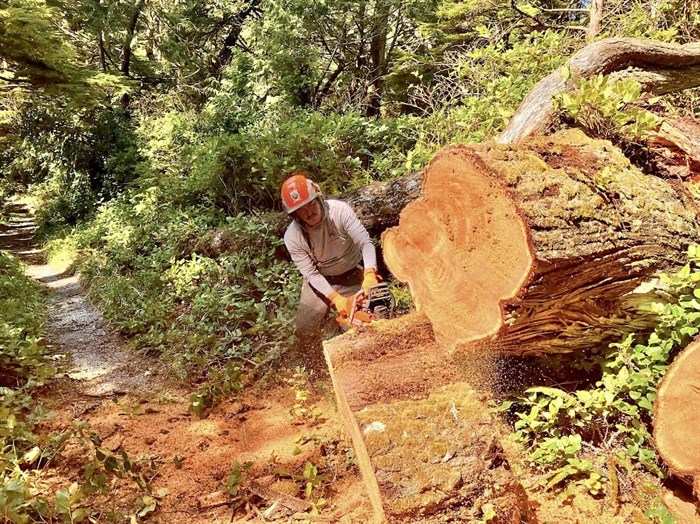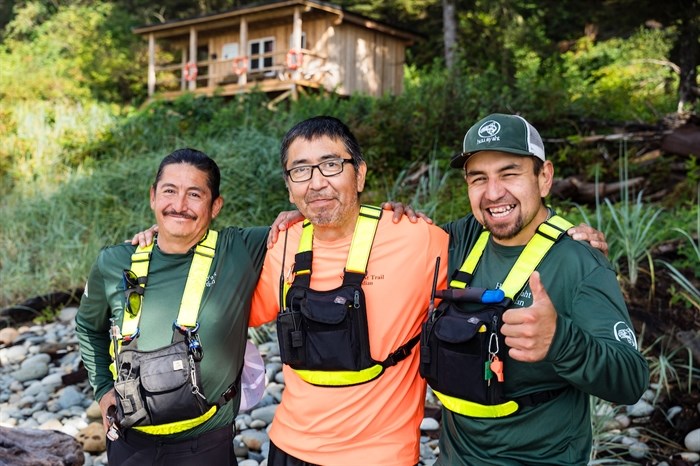
Huu-ay-aht Guardian Kevin Peters clears a tree from the West Coast Trail. This year storm damage left hundreds of downed trees and significant infrastructure damage along the route at the start of the season.
Image Credit: FACEBOOK/Kevin Peters
May 24, 2025 - 4:00 PM
Windfalls, landslides and washouts.
The iconic West Coast Trail took a serious beating from wild weather this winter — with Parks Canada warning hikers to take extra care navigating the famed hiking route in Pacific Rim National Park Reserve on the southwest edge of Vancouver Island.
Indigenous Guardians and park crews have been working hard to remove fallen trees and fix walkways, bridges and ladders wrecked by extreme weather, likely aggravated by climate change, said Huu-ay-aht Chief Councillor Sayaac?at?, John Jack.
Bouts of intense rainfall and wind along the rugged coastal trail are a routine challenge, but early-season conditions appear worse than usual, Jack said. Guardians have reported that, in just one section of the route, at least 100 trees have come down across the trail.
“This is the first time in a long time that I’ve seen this many issues pre-season,” Jack said. “The frequency, and potentially, the severity of weather impacts are worsening with climate change.”
The strenuous 75-kilometre trail, which draws thousands of visitors annually, features remote beaches and rainforests with often muddy, wet trekking or scrambling over rocks and up bluffs and ladders.
A number of Vancouver Island’s top wilderness trails suffered similar damage this year. The 47-kilometre Juan de Fuca Trail further south on the island is closed indefinitely due to storm damage, although some day-use sites remain open. The rugged North Coast Trail in Cape Scott Park is also temporarily closed due to storm damage.
Prepare for rough conditions: Parks Canada
Liam McNeil, resource conservation manager at Pacific Rim National Park, agreed damage to the trail’s infrastructure was significant, in part due to an atmospheric river event in October followed by a bomb cyclone in November.
The Guardians and trail crews got out onto the route early and worked very hard to establish some detours and make temporary infrastructure repairs at critical locations to reopen on time in early May for summer — but hikers should plan for additional delays and challenges so they can navigate the route successfully, he said. .
“Hikers planning to come to the West Coast Trail need to be aware that conditions will be more difficult than normal, especially at the start of the season,” McNeil said.
The inland route and the cable car to cross Walbran Creek, smack in the middle of the most challenging section of the trail, are out of commission due to the number of downed trees at the location. Hikers can continue along the beach but must wade across the creek to proceed — but should be prepared to wait if tides or heavy rain have swollen the river crossing.
“They may have to wait a day or so for the creek to subside in volume — and unbuckle waist and chest belts on their packs before proceeding with the utmost caution,” McNeil said.

Guardians from Huu-ay-aht First Nation, Terry Nookemus, Brian Peters, and Kevin Peters (pictured here,) and Parks Canada trail crews are working hard to deal with the extra storm damage to the West Coast Trail this year.
Image Credit: SUBMITTED
Guardians and trail need 'climate-proofing'
The Canadian Coast Guard (CCG) pulled lighthouse keepers from the Pachena and Carmanah Point stations along the trail last fall, Jack said.
The stations still have automated light systems, but staff were pulled from the sites because the CCG said land surrounding the stations was no longer stable and posed a hazard. However, relocating the stations was not considered.
While Guardians provide some measure of safety to hikers along the trail, lighthouse-keepers acted as an extra layer of protection, Jack said.
“With no staff at these lighthouses anymore, they can't help when somebody's hurt. They can't help if some boats on the shore get into trouble,” he said.
Though the closure of the lighthouses is not a Parks Canada decision, it’s part and parcel of the federal government adequately resourcing the West Coast Trail, he said.
“Damage to the trail is an example of the impact that climate change is having on our day-to-day lives,” he said.
As the stewards of the lands and waters in their territory, the Huu-ay-aht, Ditidaht and Pacheedaht Trail Guardians partner with the park to maintain the trail, provide cultural insights and assistance to hikers, and protect the environment.
Maintenance of trail infrastructure is labour-intensive, and ensuring safety is a shared priority for the Guardians and Parks Canada, Jack said.
The Guardians are highly skilled and adaptable but may need more support if the climate impacts continue to drive up maintenance and repairs. As the eyes and ears on the trail, they are in a good position to assess whether more bodies or resources will be needed in coming years, Jack said.
“There’s definitely a kind of climate change adaptation and mitigation aspect to this,” he said, noting the Huu-ay-aht, along with other Nuu-chah-nulth Nations and Parks Canada, co-manage the reserve.
“We just need to be aware and be cognizant of the fact that we're going to need to invest as a country in climate mitigation and climate adaptation. And you know, the trail is an example of that.”
— This article was originally published by Canada's National Observer
News from © iNFOnews, 2025